Interesting Science Videos
Exocrine Glands Definition
- Exocrine glands are the glands with ducts that allow the cells to secrete their products into those ducts so that they can be released onto the surface of the target cells or organs.
- The cells of the exocrine glands are linked to the covering epithelium by narrow tubular ducts that carry the secretions to their target sites.
- The secretions of exocrine glands do not mix with the bloodstream as some of these products might even be harmful if released into the blood.
- The secretions of exocrine glands can be enzymes, ions, water, mucins, or chemical substances that assist the normal functioning of the body.
- The exocrine glands can be unicellular or multicellular, depending on the complexity of the glands and their functions.
- Unicellular glands are single-celled glands that secrete mucus directly onto the surface of the epithelium.
- Multicellular glands are composed of more than just one cell and have a macroscopic structure with ducts.
- Exocrine glands are composed of a secretory unit that contains a stroma of connective tissue where each such unit is connected to a smaller duct to finally form the main duct of the gland.
- Multicellular exocrine glands can be further divided into types depending on the shape of the secretory unit and the branching of the ducts.
- Exocrine glands with unbranched ducts are called simple exocrine glands, whereas those with branched duct systems are called compound exocrine glands.
- Exocrine glands with round secretory units are called acinar or alveolar glands, whereas those with tubular secretory units are called tubular glands.
- Since exocrine glands release their secretion onto the surface of the epithelial layer, these can also be differentiated as apocrine, merocrine, and holocrine on the basis of their mechanism of release of those secretions.
- The secretory unit of the exocrine gland contains cells equipped with well developed endoplasmic reticulum and Golgi apparatus.
- Some of the examples of exocrine glands include the sweat gland, liver, pancreatic acini, salivary glands, mammary glands, etc.
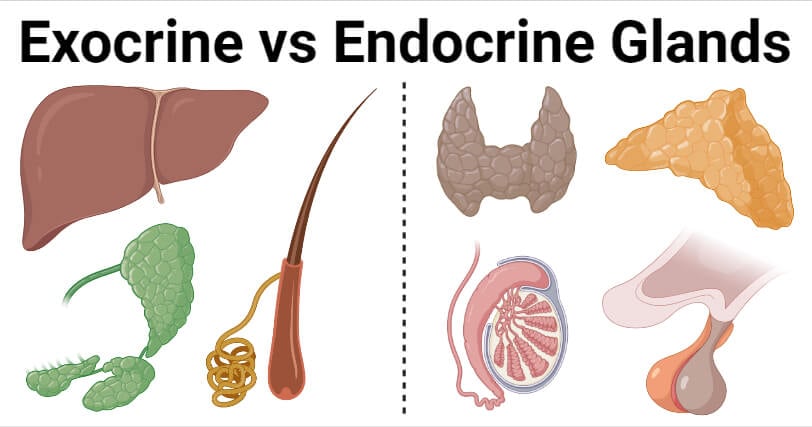
Endocrine Glands Definition
- Endocrine glands are the glands that do not have a duct system and release their secretions or hormones directly into the bloodstream.
- The products of endocrine glands are called hormones that are released by the cells into the interstitial fluid. These then eventually diffuse into the bloodstream without passing through a duct system.
- Hormones usually are very active in smaller doses and have far-reaching effects as these are released directly into the bloodstream.
- The lack of ducts in endocrine glands has been speculated to be due to the fact that these eventually lost the connection with their original epithelium during development.
- Endocrine glands are one of the most vascularized organs in the body, and the thin-walled capillaries enable the diffusion of hormone from the secreting cells into the interstitial fluid.
- The hormones produced by endocrine glands are generally proteins or steroids, and these are synthesized by the glandular epithelium without myoepithelial cells.
- The transport of hormones from the glands to the target organs depends on receptors that might be present either on the secreting cells or the cells nearby them.
- The response time for the action of endocrine hormones is usually longer as these need to be transported to the site of action.
- Endocrine glands monitor the long-term activities of the body and influence the general metabolism and growth of the body.
- The secretory cells of the endocrine glands have a thin cell membrane to ensure the diffusion of hormones. These cells tend to be rich in the endoplasmic reticulum.
- The hormones diffused out of the glands are carried by receptors present either on the secretory cell or the surrounding cells.
- Endocrine glands can also be differentiated into three distinct types; trabecular type, follicular type, and disseminated type.
- Trabecular-type glands contain cells that are arranged in cords. Follicular-type glands contain cells arranged in spheres, and the disseminated type contains cells that remain scattered.
- Some examples of endocrine glands are the adrenal gland, pituitary gland, ovaries, thyroid gland, etc.
Key Differences (Exocrine Glands vs Endocrine Glands)
| Characteristics | Exocrine Glands | Endocrine Glands |
| Definition | Exocrine glands are the glands with ducts that allow the cells to secrete their products into those ducts so that they can be released onto the surface of the target cells or organs. | Endocrine glands are the glands that do not have a duct system and release their secretions or hormones directly into the bloodstream. |
| Ducts | Exocrine glands have one or more ducts that transport their secretions. | Endocrine glands are ductless glands that release the hormones directly into the bloodstream. |
| Secretions | The secretions of exocrine glands are enzymes, mucins, ions, water, etc. | The secretions of endocrine glands are hormones. |
| Target site | The target sites of the gland are located close to the exocrine gland. | The target sites of the endocrine glands are present away from the gland. |
| Response | Exocrine glands usually show rapid response as the secretions are released directly into the target organs. | Endocrine glands exhibit delayed response as the secretions need to be transported to the site of action. |
| Types | Exocrine glands can be differentiated into different types like unicellular and multicellular exocrine glands, merocrine, apocrine and holocrine glands, etc. | Endocrine glands are of three distinct types; trabecular type, follicular type, and disseminated type. |
| Function | Exocrine glands monitor the short-term activities and functions of the target organs. | Endocrine glands control the overall structure, growth, and development of the target organs. |
| Examples | Some examples of exocrine glands include the sweat gland, liver, pancreatic acini, salivary glands, mammary glands, etc. | Some examples of endocrine glands are the adrenal gland, pituitary gland, ovaries, thyroid gland, etc. |
Examples of Exocrine Glands
Liver
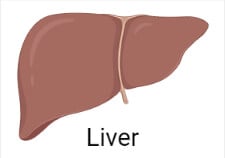
- The liver is the largest exocrine gland in the body which is responsible for the metabolism of most biomolecules.
- The liver occurs in the upper quadrant of the abdomen and is considered a part of the digestive system.
- The most important function of the liver is the breakdown of fat by the secretion of bile juice that contains bile acids and cholesterol.
- The liver is composed of specialized tissue made up of hepatocytes that are arranged in certain patterns within the gland.
- The bile juice secreted by the liver is transported through the common bile duct into the gall bladder before passing to the stomach.
Salivary glands
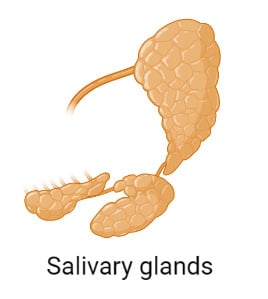
- There are three types of salivary glands occurring in human beings; parotid glands, submandibular glands, and sublingual glands.
- The glands occur within the buccal cavity and secrete about 1 to 1.5 liters of saliva every day.
- Saliva produced by these glands contains amylase, which helps in the digestion of carbohydrates into their monomeric forms.
- The enzyme produced by the glands is transported to the mouth by means of different ducts.
- Salivary glands are regulated by the parasympathetic nervous system, and the primary neurotransmitter involved in the process is acetylcholine.
Examples of Endocrine Glands
Pituitary Gland
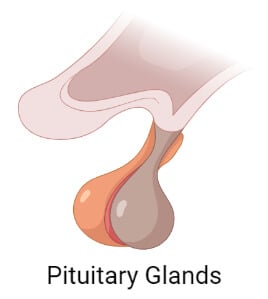
- The pituitary gland is the most important endocrine gland in the body as it controls the activity of most other endocrine glands.
- It is a small pea-shaped gland that occurs at the base of the skull and is attached to the hypothalamus of the brain via a small stalk.
- The pituitary gland consists of two distinct parts; the anterior pituitary and posterior pituitary.
- The anterior pituitary is the more prominent part of the gland, whereas the posterior pituitary occupies a smaller region.
- The anterior and posterior pituitary secrete different hormones, all of which are specialized for different functions.
- Some of the important hormones secreted by the pituitary gland include growth hormone, thyroid-stimulating hormone, and oxytocin.
- The secretion of hormones by the pituitary gland is controlled by the hypothalamus, which in turn is regulated by a negative feedback mechanism.
Adrenal Gland
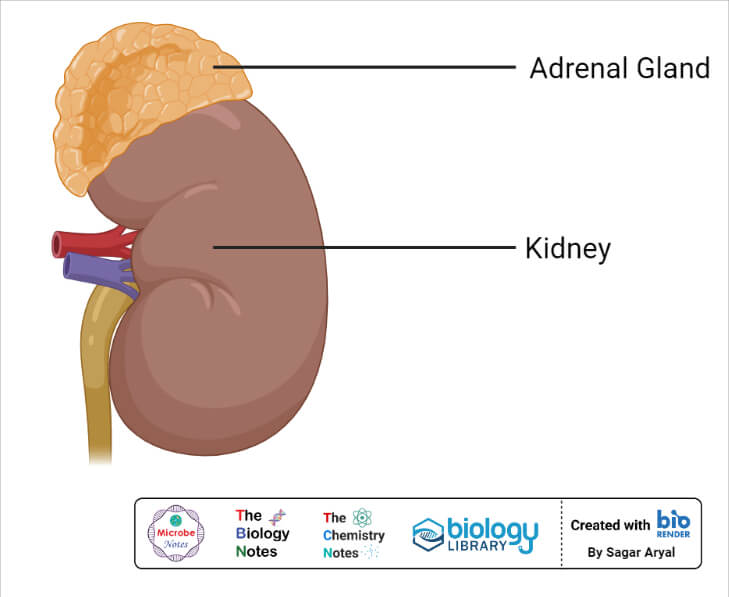
- There are two adrenal glands that are present on top of each kidney, where each of the glands is further differentiated into the adrenal medulla and adrenal cortex.
- The glands have a flattened structure and a half-moon shape. The shape and size of the gland depend on the physiological condition of the individual.
- The adrenal cortex and adrenal medulla are considered two different glands as these differ in structure, origin, and functions.
- The adrenal cortex secretes mineralocorticoids, glucocorticoids, and androgens. All of these hormones are steroid hormones.
- The adrenal medulla secretes epinephrine and norepinephrine, which help regulate the permeability of the blood vessels.
- The hormones of the adrenal glands help in the metabolism of different biomolecules like carbohydrates, proteins, and fatty acids.
References
- Hall JE and Guyton AC. (2011) Textbook of Medical Physiology. Twelfth Edition. Elsevier Saunders.
- Waugh A and Grant A. (2004) Anatomy and Physiology. Ninth Edition. Churchill Livingstone.
- Marieb EN and Hoehn K. (2013) Human Anatomy and Physiology. Ninth Edition. Pearson Education, Inc.
- Rastogi SC. (2007) Essentials of Human Physiology. Fourth Edition. New Age International Limited

Very good and easy understanding